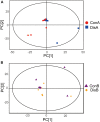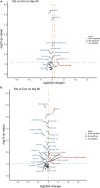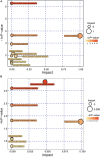Serum Metabolomic Profiling to Reveal Potential Biomarkers for the Diagnosis of Fatty Liver Hemorrhagic Syndrome in Laying Hens
- PMID: 33633583
- PMCID: PMC7900428
- DOI: 10.3389/fphys.2021.590638
Serum Metabolomic Profiling to Reveal Potential Biomarkers for the Diagnosis of Fatty Liver Hemorrhagic Syndrome in Laying Hens
Abstract
Fatty liver hemorrhage syndrome (FLHS), a nutritional and metabolic disease that frequently occurs in laying hens, causes serious losses to the poultry industry. Nowadays, the traditional clinical diagnosis of FLHS still has its limitations. Therefore, searching for some metabolic biomarkers and elucidating the metabolic pathway in vivo are useful for the diagnosis and prevention of FLHS. In the present study, a model of FLHS in laying hens induced by feeding a high-energy, low-protein diet was established. Gas chromatography time-of-flight mass spectrometry (GC-TOF-MS) was used to analyze the metabolites in serum at days 40 and 80. The result showed that, in total, 40 differential metabolites closely related to the occurrence and development of FLHS were screened and identified, which were mainly associated with lipid metabolism, amino acid metabolism, and energy metabolism pathway disorders. Further investigation of differential metabolites showed 10 potential biomarkers such as 3-hydroxybutyric acid, oleic acid, palmitoleic acid, and glutamate were possessed of high diagnostic values by analyzing receiver operating characteristic (ROC) curves. In conclusion, this study showed that the metabolomic method based on GC-TOF-MS can be used in the clinical diagnosis of FLHS in laying hens and provide potential biomarkers for early risk evaluation of FLHS and further insights into FLHS development.
Keywords: biomarkers; diagnosis; fatty liver hemorrhage syndrome; gas chromatography time-of-flight mass spectrometry; metabolomics; serum.
Copyright © 2021 Guo, Kuang, Zhuang, Jiang, Shi, Huang, Zhou, Xu, Liu, Wu, Hu and Guo.
Conflict of interest statement
The authors declare that the research was conducted in the absence of any commercial or financial relationships that could be construed as a potential conflict of interest.
Figures








Similar articles
-
Untargeted and targeted metabolomics profiling reveals the underlying pathogenesis and abnormal arachidonic acid metabolism in laying hens with fatty liver hemorrhagic syndrome.Poult Sci. 2021 Sep;100(9):101320. doi: 10.1016/j.psj.2021.101320. Epub 2021 Jun 10. Poult Sci. 2021. PMID: 34274572 Free PMC article.
-
Quantitative lipidomics reveals lipid perturbation in the liver of fatty liver hemorrhagic syndrome in laying hens.Poult Sci. 2023 Feb;102(2):102352. doi: 10.1016/j.psj.2022.102352. Epub 2022 Nov 19. Poult Sci. 2023. PMID: 36473380 Free PMC article.
-
Protective effects of genistein on the production performance and lipid metabolism disorders in laying hens with fatty liver hemorrhagic syndrome by activation of the GPER-AMPK signaling pathways.J Anim Sci. 2023 Jan 3;101:skad197. doi: 10.1093/jas/skad197. J Anim Sci. 2023. PMID: 37314978 Free PMC article.
-
Insulin resistance and metabonomics analysis of fatty liver haemorrhagic syndrome in laying hens induced by a high-energy low-protein diet.Sci Rep. 2019 Jul 12;9(1):10141. doi: 10.1038/s41598-019-46183-y. Sci Rep. 2019. PMID: 31300671 Free PMC article.
-
Osteocalcin and Its Potential Functions for Preventing Fatty Liver Hemorrhagic Syndrome in Poultry.Animals (Basel). 2023 Apr 18;13(8):1380. doi: 10.3390/ani13081380. Animals (Basel). 2023. PMID: 37106943 Free PMC article. Review.
Cited by
-
Effect of Bile Acids Supplementation in Fatty Liver Hemorrhagic Syndrome, Production Performance, Physiological and Quality Characteristics of Laying Hen Eggs.Animals (Basel). 2024 Jun 28;14(13):1910. doi: 10.3390/ani14131910. Animals (Basel). 2024. PMID: 38998024 Free PMC article.
-
Hepatoprotective effects of magnolol in fatty liver hemorrhagic syndrome hens through shaping gut microbiota and tryptophan metabolic profile.J Anim Sci Biotechnol. 2024 Sep 6;15(1):120. doi: 10.1186/s40104-024-01074-9. J Anim Sci Biotechnol. 2024. PMID: 39238062 Free PMC article.
-
Gut Microbiota and Serum Metabolite Potential Interactions in Growing Layer Hens Exposed to High-Ambient Temperature.Front Nutr. 2022 Apr 27;9:877975. doi: 10.3389/fnut.2022.877975. eCollection 2022. Front Nutr. 2022. PMID: 35571932 Free PMC article.
-
Plasma Metabolomics Identifies the Dysregulated Metabolic Profile of Primary Immune Thrombocytopenia (ITP) Based on GC-MS.Front Pharmacol. 2022 May 24;13:845275. doi: 10.3389/fphar.2022.845275. eCollection 2022. Front Pharmacol. 2022. PMID: 35685646 Free PMC article.
-
Taurine Protects against the Fatty Liver Hemorrhagic Syndrome in Laying Hens through the Regulation of Mitochondrial Homeostasis.Int J Mol Sci. 2023 Jun 20;24(12):10360. doi: 10.3390/ijms241210360. Int J Mol Sci. 2023. PMID: 37373507 Free PMC article.
References
LinkOut - more resources
Full Text Sources
Other Literature Sources
Miscellaneous

